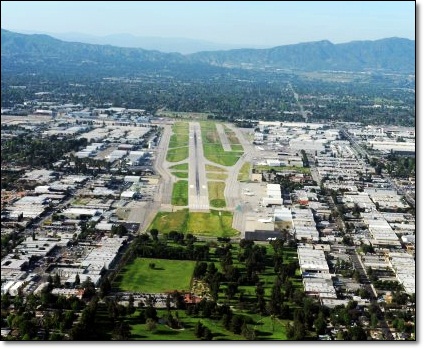 Once-booming Van Nuys Airport flies into stormy skies
Once-booming Van Nuys Airport flies into stormy skiesThe number of flights at Van Nuys Airport has been decreasing steadily year to year.
Van Nuys Airport traffic has taken a nose dive over the past decade, with blame being placed on everything from poor management and high rents to a precipitous decline in propeller planes.
Once the nation’s busiest general aviation airport, Van Nuys has watched its traffic shrink by half over the decade to levels not seen since the early 1960s.
Some say that Van Nuys Airport – the economic engine of the San Fernando Valley – is in a state of economic emergency, with airplane business at top airport companies down 30 percent to 45 percent.
Airport officials say the poor economy has led to a few tough years, but say the facility could be poised for a revival.
“If you look at it as a whole, we’ve always been up and down,” said Diana Sanchez, spokeswoman for Van Nuys Airport. “Will we hit 600,000 (operations) again? It’s hard to say.
“The overall health of the airport is good. … We’re in the black, with $1 million in anticipated revenue next fiscal year.”
The number of takeoffs and landings have fallen by roughly 10 percent a year since 1999, when the airport had nearly 607,000 aircraft operations, according to airport records.
By last year, the airport known as VNY had fallen to 339,000 combined takeoffs and landings – the lowest since 1963.
“My biggest beef is: No one can make a decision or do anything,” said Mike Konle, an entertainment industry businessman who owns a twin-engine Cessna and is a member of an airport hangar association, who has flown out of Van Nuys Airport since 1975. “No one’s running it like a business.
“We’re overtaxed. Rents are too high. We’re all paying (to support) the few people that are left.”
While some critics have called for privatization of airport management, others have called for an airport commission to answer to the needs of VNY.
Whatever the case, everyone agrees Van Nuys Airport deserves much more support from the city, whose Los
Angeles World Airports agency also manages Palmdale Regional and Los Angeles and Ontario International airports. Airport manager Jess Romo, who also manages Ontario International, and Mike Molina, the airport’s deputy director of external affairs, did not respond to requests for comment.
During the nation’s largest business aviation convention last fall, no LAWA officials were on hand to promote – and draw business – to the flagging airport.
“The two biggest economic drivers in the San Fernando Valley are Van Nuys and Burbank airports,” said Rob Gilmore, director of investor relations for the Valley Economic Alliance. “Their interests are our interests – and they need to be coddled.”
On the eve of the recession in late 2007, an economic study credited Van Nuys Airport for contributing $1.3 billion to the local economy, while generating more than 12,300 jobs.
But as the study heralded the 730-acre airport as No. 1 in the nation for propeller-driven and corporate jet traffic, it had already been surpassed by Deer Valley Airport outside Phoenix.
That has meant less business for surrounding hotels, bars, restaurants and airport service facilities.
At the Airtel Plaza Hotel near the airport’s storied One-Six-Right runway, occupancy rates are down “substantially,” said its owner, Jim Dunn.
“A healthy airport is a healthy hotel,” Dunn said. “If Los Angeles promotes its business airport, there will be more traffic here.”
Hangars across the runway have record vacancy rates, as high as 20 percent, while rental rates to smaller tenants have plunged, lease holders say.
On the tarmac outside, vacancies of propeller plane tie-downs are much higher.
Airplane fuel sales, whose city fees were nearly tripled two years ago, have fallen by 30 percent.
And while a planned propeller park has been stalled for several years, airport business owners say as many as $70million in airport development projects – including 500,000 square feet of unbuilt hangars – have been held up by current lease negotiations between the airport master leaseholders, or so-called fixed-base operators.
“There’s been an economic crisis, and in order to maximize opportunities after this economic downturn, they have to stabilize rents,” said Curt Castagna, president of the Van Nuys Airport Association, which represents 100 aviation and non-aviation tenants.
What was supposed to have been a streamlined leasing process – with standardized rates instead of the current ad hoc leases – is now two years behind the mandated timeline set by the City Charter, Castagna said.
Without standard, long-term contracts with the city, they say leaseholders have had difficulty obtaining bank loans – and have put the brakes on development plans.
The tardy leases could also mean retroactive rental payments that could easily run into the millions to major leaseholders and their tenants.
Others accuse the airport managers of trying to raise property lease rates while many aviation businesses struggle to stay airborne.
“We’re talking with them now, but there’s no real effort to resolve it,” said airport patriarch Clay Lacy, founder of Clay Lacy Aviation, who is a fixed-base operator. “They want to raise rents 50 percent or more, but it doesn’t make sense, because nobody is really making it.”
By 1976, it recorded a record 618,000 takeoffs or landings of mostly propeller planes, to become the busiest general aviation airport in the nation.
Many blame the loss of such piston-driven aircraft – and a half dozen large flight schools, the last closing last year – for the overall decline of Van Nuys Airport’s total traffic.
Three decades ago, there were as many as 1,400 prop-driven Cessnas and other piston planes. By 2009, there were less than 400 – the remainder finding homes at cheaper airports in Pacoima or Camarillo. And when the small planes left, so did many flight schools, including Van Nuys Flight Center, last year.
